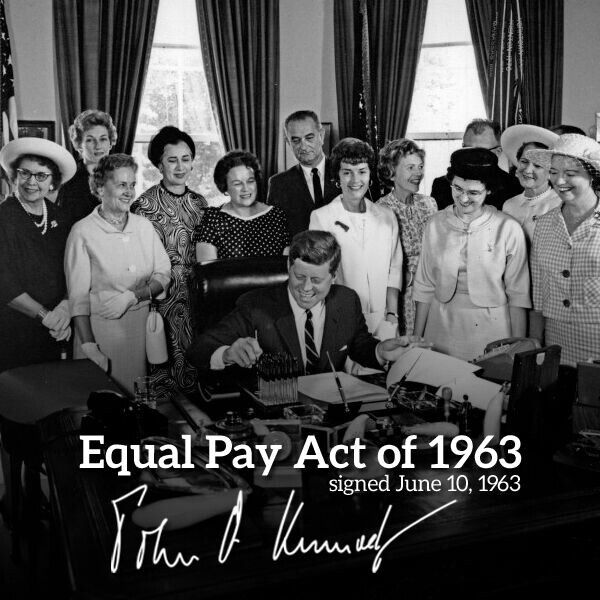In the United States of America, the gender wage gap is based on the statistic that a woman earns approximately $0.77 for every $1.00 that a man earns, but not many people understand how this figure is derived or what it even shows.1 By taking the median amount of earnings that women make in a single year and dividing this figure by the median amount of earnings that men make in a single year, the gap is revealed; however, this gap does not mean that, for the same work and qualifications, a woman will be paid $0.77 for every $1.00 that a man makes; this has been outlawed for decades: The 88th Congress of the United States passed the 1963 Equal Pay Act, which makes sex discrimination in the workforce illegal, and this law has been in effect for over fifty years.2 In addition, Harvard economist Claudia Goldin has stated that “the gender gap in wages is closing.”3 With this in mind, the question remains: why is there still a wage gap?

While it is true that there is a gap between the amount of money that men and women earn, the gap does not exist primarily because of sexism or discrimination (although this, unfortunately, is still a factor); instead, it is mainly because of the different life choices that the average man and the average woman make.
The data shows that men and women tend to go into different career fields. For example, women tend to go into the health services and social services sectors, while men tend to go into fields relating to science, technology, engineering, and mathematics (STEM).4 With regards to how the wage gap is calculated (dividing the median amount of earnings per year that a woman makes by the median amount of earnings per year that a man makes), it makes sense that there is a wage disparity if men tend to go into STEM fields while women tend to go into jobs relating to health and social services sectors.5 One could argue that more men go into STEM-related fields than women because of sexism or discrimination, and this may have been a valid point in the past; however, in recent years, the evidence reveals the opposite: women are prioritized in fields relating to STEM precisely because men tend to dominate in STEM-related careers. In fact, females are approximately two times as likely to be chosen over equally qualified men for STEM faculty positions.6 Further data from the Washington Post reveals that, even though the evidence shows that men tend to dominate in STEM fields, this is not primarily due to sexism or discrimination: “This is the latest in a series of studies by the Cornell researchers, many of which have concluded that the scarcity of female faculty in science departments (about 20 percent in most fields) can’t be blamed on innate sexism. In a study published in the journal Psychological Science in the Public Interest, they found that young and mid-career women are more likely to receive job offers than male candidates, are paid roughly the same amount, are granted tenure and promoted at the same rate (except in economics), remain in their fields for the same amount of time, and are about as satisfied with their jobs. The study attributes the lack of female scientists to early educational choices — like opting not to take Advanced Placement calculus and physics in high school or choosing not to declare a math-intensive major in college — rather than discrimination later on.”7
Regardless of where one is on planet earth, there will always be 24 hours in a day, 168 hours in a week, and 8,760 hours per year. Even though these numbers are the same for everyone on earth, everyone uses them differently in the workweek. For example, the average man working full time works 8.2 hours per day, while the average full-time woman works 7.8 hours per day. If men and women are compared further (without taking into account part-time work), then it’s revealed that men tend to work an average of 42 more minutes than women; although 42 minutes might not seem like much time, it does translate into many hours in the long run: an additional 42 minutes per day at work means that men, on average, are working 3.5 hours more than women per week, or an additional 14 hours per month.8 This extra amount of time means that men will be paid more money than women, since, on average, they work more than women. With this in mind, when calculating the earnings of women compared to the earnings of men, the disparity in wage makes sense.
Why is it that there is a vast disparity between the men and women in professional sports in the United States of America? The median salary for a player in the National Basketball Association (NBA) in 2015 was $2,505,720.9 The median salary for a player in the Women’s National Basketball Association (WNBA) is approximately $71,635.10 Even though both a woman from the WNBA and a man from the NBA are playing the same game, why is there a massive gap in the amount of money made? It appears that the answer can be derived from economics. With regard to economics, there are two forces at play: the law of supply and the law of demand. The law of demand states that there is an inverse relationship between price and quantity demanded.11 In other words, the more expensive a product becomes, the less likely consumers are to purchase it. The law of supply states that there is a positive relationship between price and quantity supplied.12 This means that if a supplier of a product realizes that the demand for a product is high, then the supplier can charge more money because he or she knows that people will pay for the product. Because the NBA knows the demand to see their games is high, the supplier (the NBA) can charge a lot of money for their tickets. On the other hand, the WNBA is not as popular compared to the NBA. Because the demand for WNBA games is not as high as NBA games, the supplier cannot charge as much money compared to the NBA, which means that the WNBA players will not make as much as NBA players. Another reason why NBA players tend to make more money is that their season is 82 games, while the WNBA players’ season is only 18 games; this means that there is more time for money to be collected for NBA players than in the WNBA. As can be seen, the disparity in money from an NBA player’s salary and a WNBA player’s salary has little to do with sexism or discrimination and everything to do with the way economics works.

It seems that the wage gap is primarily a product of multiple factors, such as the choice of job that the average man or the average woman takes, the number of hours that the average man and the average woman works, and because of economics. Having said this, what happens when these factors are accounted for? If the equation to find the gender wage gap accounts for these variables, then there is a small disparity between the amount of money that a man makes versus the amount of money that a woman makes. This small disparity seems like, unfortunately, a product of sexism and discrimination. One major form of discrimination in the workforce that women face is vertical (or hierarchical) segregation, which “refers to the fact that men are much more likely than women to be in positions of authority.”13 However, the United States government and businesses have begun to take notice of this and are now trying to do their best to reduce this form of discrimination. For example, women now own approximately half of all the United States companies.14 Also, President Barack Obama signed the Lilly Ledbetter Fair Pay Act in 2009, which made it much more difficult for businesses to take advantage of women by not paying them their fair share.15 This shows that, while discrimination and sexism play a role in a part of the wage gap, it is, thankfully, dying out and becoming less and less of a problem.

The gender wage gap is a complex issue. While it is still a problem in the United States of America, great strides are being made to reduce it. The gender wage gap appears to have multiple components, such as the amount of time working, the jobs that men and women go into, and, in part, economics. However, after accounting for this, there seems to be a percentage of the wage gap that doesn’t disappear; this percentage seems to be derived from sexism and discrimination. With this said, there is hope: laws have been passed in recent years to combat this unfortunate case of sexism and discrimination, and the workforce is more pro-women than at any other point in the history of the United States of America.16 Additionally, there is a global effort to reduce the inequality between man and woman: The United Nations adopted the Universal Declaration for Human Rights in 1948, which states that everyone has the right to equal pay for the same work.17 Although it is unfortunate that there is still a wage gap, there is a good trend in America with regards to the gender wage gap: it is decreasing. Hopefully, one day, the wage gap will be a thing of the past.
- Encyclopedia of Social Problems, 2008, s.v. “Wage Gap,” by Vincent N Parrillo. ↵
- The Wiley Blackwell Encyclopedia of Family Studies, 2016, s.v. “Gender Wage Gap,” by Emira Danad. ↵
- Reihan Salam, “Which Gender Gap?” National Review 66, no. 1 (January 27, 2014): 19-20. ↵
- “Students in STEM Fields by Gender and Race/Ethnicity,” CollegeBoard, https://trends.collegeboard.org/education-pays/figures-tables/students-stem-fields-gender-and-race-ethnicity. ↵
- Kerry Close, “STEM Majors Will Earn Highest Salaries This Year,” Time, January 21, 2016, http://time.com/money/4189471/stem-graduates-highest-starting-salaries/. ↵
- Ted Boscia, “Women Preferred 2:1 Over Men for STEM Faculty positions, “Cornell Chronicle, April 13, 2015, http://news.cornell.edu/stories/2015/04/women-preferred-21-over-men-stem-faculty-positions. ↵
- Sarah Kaplan, “Study Finds, Surprisingly, That Women Are Favored for Jobs in STEM,” The Washington Post, April 14, 2005, https://www.washingtonpost.com/news/morning-mix/wp/2015/04/14/study-finds-surprisingly-that-women-are-favored-for-jobs-in-stem/?noredirect=on&utm_term=.1be2c8a73649. ↵
- Karin Agness, “New Report: Men Work Longer Hours Than Women,” Forbes, June 30, 2016, https://www.forbes.com/sites/karinagness/2016/06/30/new-report-men-work-longer-hours-than-women/#7166f2e518b4. ↵
- Tome Gerencer, “How Much Money Does an NBA Player Make?” Money Nation, November 13, 2016, http://moneynation.com/how-much-money-does-an-nba-player-make/. ↵
- Paulana Lamonier, “The Business Of Being A WNBA Player,” Forbes, July 2, 2018, https://www.forbes.com/sites/plamonier/2018/07/02/the-business-of-being-a-wnba-player/#11d4d5c35af1. ↵
- Timothy Taylor, Courseware Print Companion for Micro Economics (unknown, 2016), 19. ↵
- Timothy Taylor, Courseware Print Companion for Micro Economics (unknown, 2016), 20. ↵
- Encyclopedia Britannica, 2018, s.v. “Gender wage gap,” by Medora W. Barnes. ↵
- Williams G. Nickels, James M. McHugh, and Susan M. McHugh, Understanding Business 12th Edition (New York: McGraw-Hill Education, 2016), 130. ↵
- From Suffrage to the Senate: America’s Political Women, 2013, s.v. “Lilly Ledbetter Fair Pay Act of 2009,” by Suzanne O’Dea. ↵
- Bryce Covert, “Closing the Wage Gap for Women,” New Republic, no. 249 (July 2018): 4-6. ↵
- Gale Encyclopedia of U.S. Economic History, 2015, s.v. “Gender Wage Gap,” by Ermira Danaj. ↵



44 comments
Amanda Uribe
This article was very interesting to read. I think that it is fair to say that there are some factors that can skew the gender wage gap. However, I think that there is still discrimination against women in the work place that may effect the wage gap as well. I think there is no certain statistics that can prove that there is a wage gap but I am glad that we have only progressed as a country and I hope we continue to progress.
Andrew Gonzales
Having read this and being a STEM major I’m truly surprised over theses results. Its only surprising that the wage gap is still a think after all we’ve done to try to abolish it. The argument that is present is amazing and has incredible facts to support it. I believe that men and women should be treated equally and I hope one day we come together to making it possible.
Lilia Seijas
Although I might disagree with the author stating that discrimination and sexism only make a small part of the wage gap, I will agree with the idea that multiple factors play a role in this issue. Sexism and discrimination to me play a bigger role than the other factors discussed in the article because women are still expected to go home and take care of the family. Although not every woman has a family to take care of, the stereotype of the working woman being unattentive still has contributed to the sexism that exists today, which is why there is an unconscious bias towards women in the workplace.
Mariana Beltran
This was a very interesting article and I believe it did a great job presenting the argument. There are so many different factors that affect the gender wage gap and the author did a great job at using them to his advantage. I believe that there is less of a difference in the wage gap today but it is still a problem and men and women should come together to achieve this equality. This was a good read and it helped me over my eyes and be more aware of the issues that still take place today.
Sarah Uhlig
I appreciated how the author went forward with their article in how they phrased certain topics and how it flowed. I do believe that this is still a issue that needs to be fixed and that there is so much more that needs to be done besides the amount of pay that women receive for their work. Women go through a chunk of difficult issues and this article was very good about addressing such a serious and still running topic.
Danielle Slaughter
I appreciate the balanced points that went into writing this particular article. As a woman, I find it to be quite insulting that females are continuously suppressed in the workforce, but I suppose it is comforting to know that it isn’t “all” on the basis of sex. I hear an argument all the time that if an employer could really get away with paying women less, he would simply fire his male employees and hire all females. Of course, because this is not the case, there must be something systematic going on.
Felicia Stewart
The gender wage gap has been a major topic of discussion, especially in recent years. With feminists and other major groups that advocate for equal rights for women it is becoming more and more prevalent. This was a very interesting article and I believe it did a great job presenting the argument. I do believe that there are many factors that go into the gender wage gap, and one of which being the specific professions that each gender goes into. Overall, this was a great read!
Joshua Garza
This article is great. It definitely gives some insight as to what is and has been going on in america for quite some time where women are getting short changed simply because of their gender and not based on how they can do the job that is given. Acts such as this one passed by JFK in 1963 definitely pushes towards the ultimate goal of true equality we should wish to reach one day.
Bianca-Rhae Jacquez
The gender wage-gap has been a huge discussion for decades that will not stop. It is true that some people don’t actually understand how the wage gap works or what it means, but this article goes to the lengths to show how it can be understood. It is absolutely deplorable that in this day and age women are not paid the same for the same work that a man is doing.
Priscilla Reyes
The article is eye-opening because it gives a perspective of the different fields and provides a comparison between salaries. I believe there is a big difference between the number of women in power or authorial positions and companies are responsible for it. However, I do believe the problem is simplified all the time because the issue goes beyond gender and into racial and ethnic questions. Nevertheless, I think few job opportunities provide good pay and benefits for their workers and this is a broader issue.